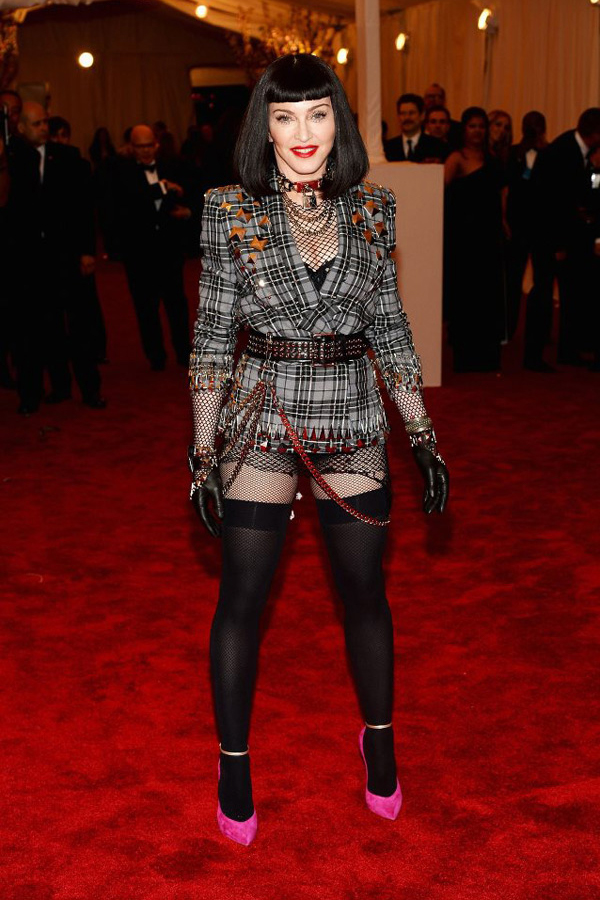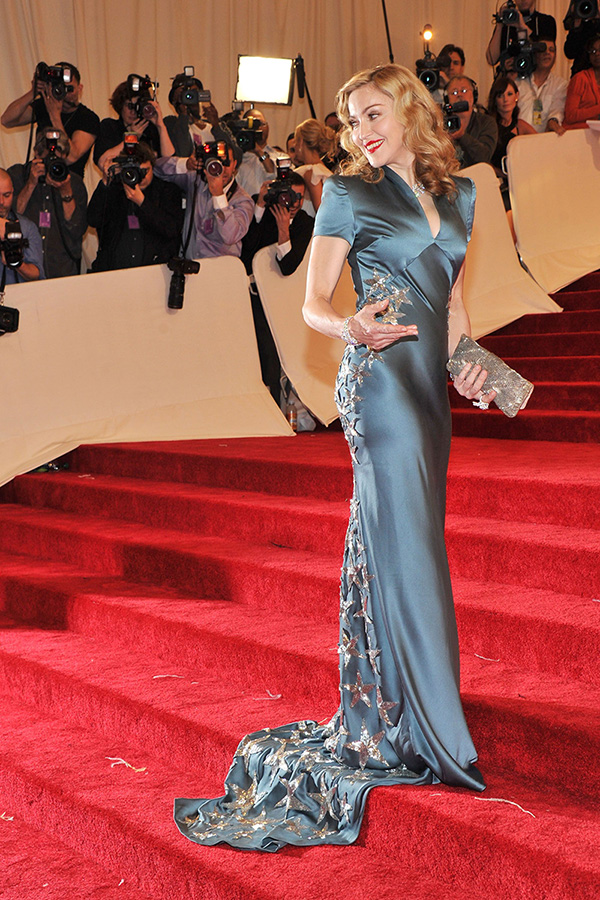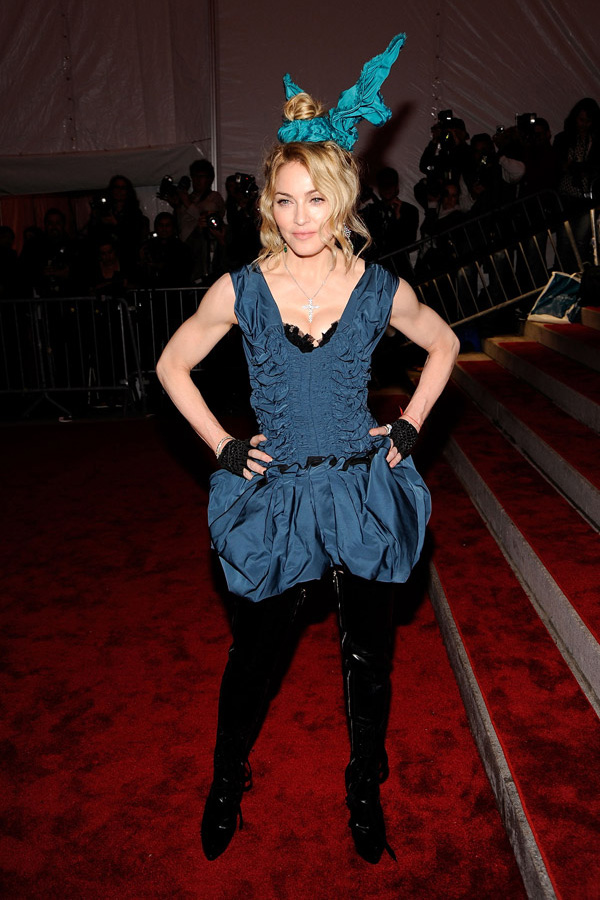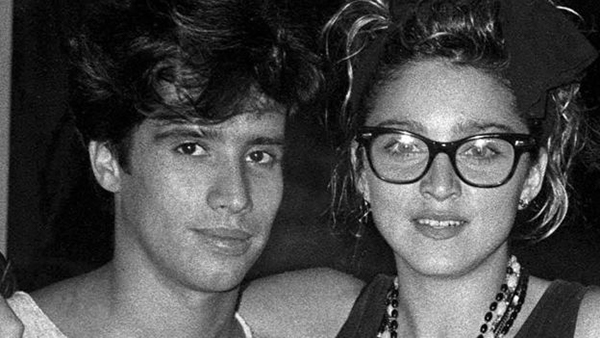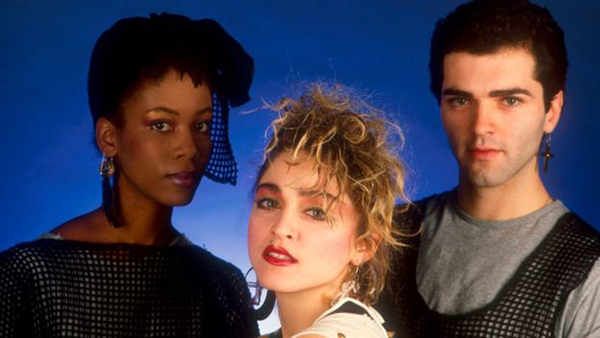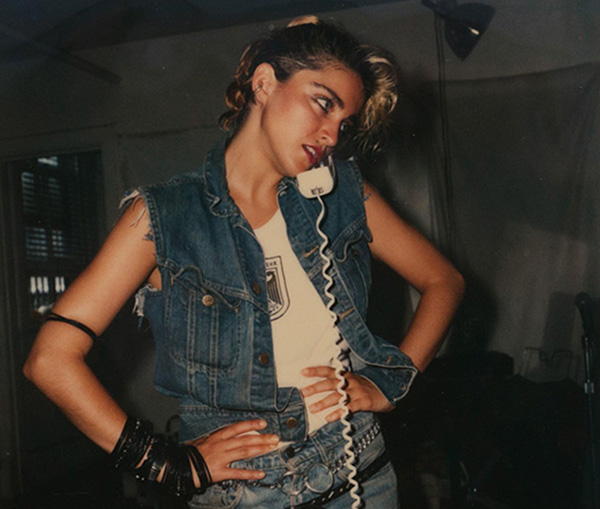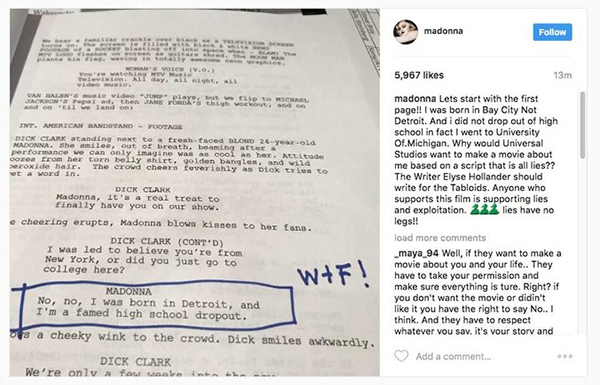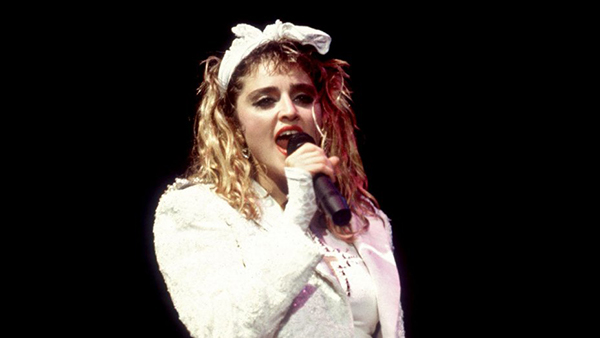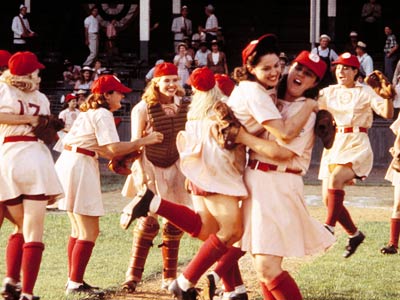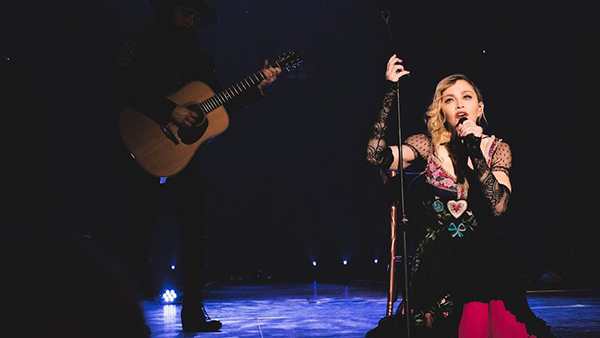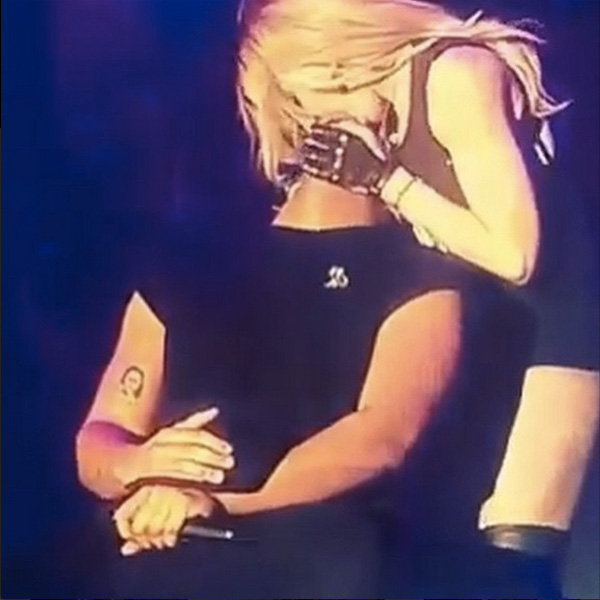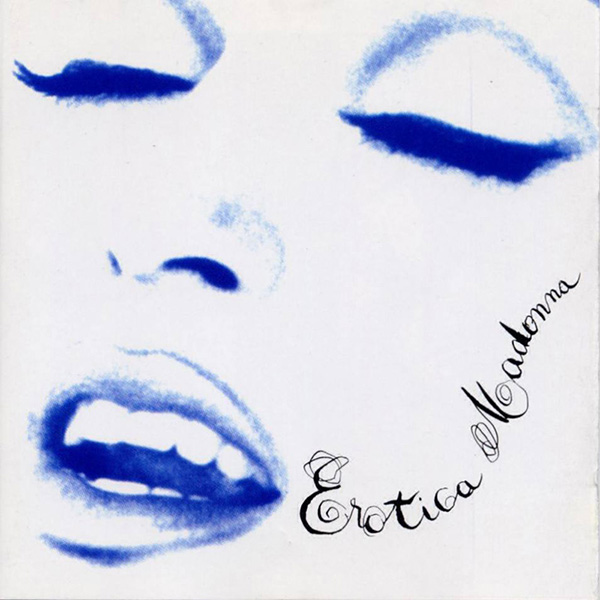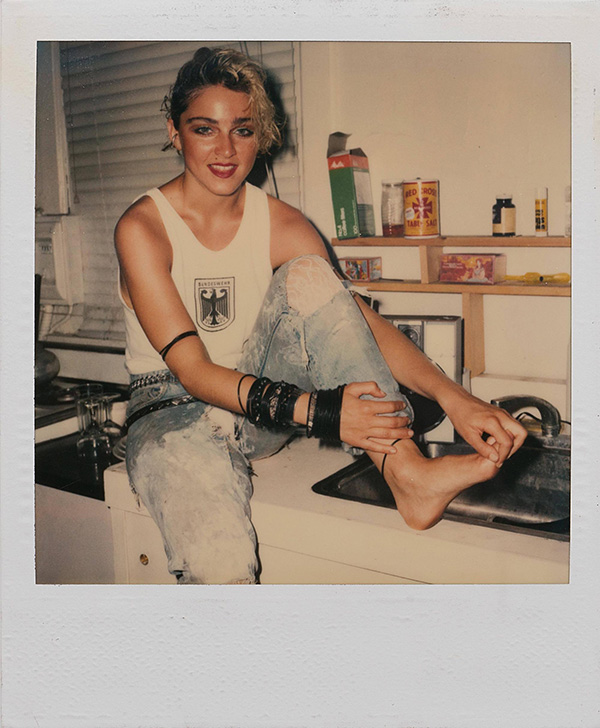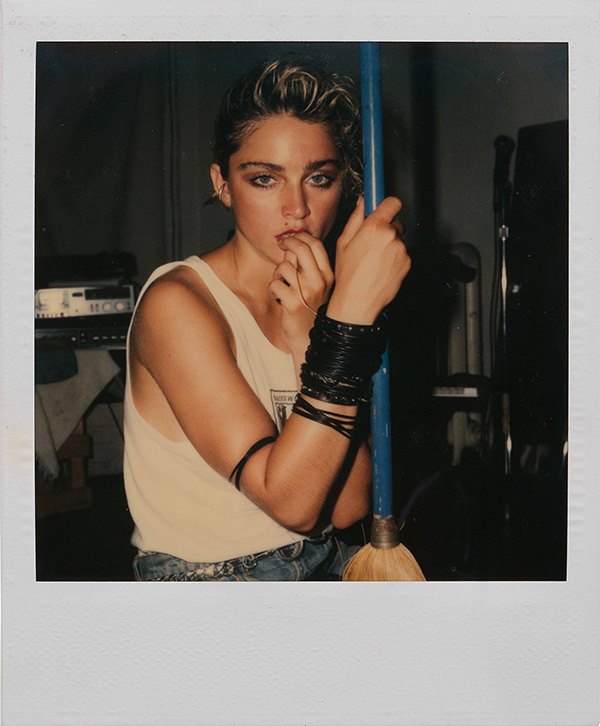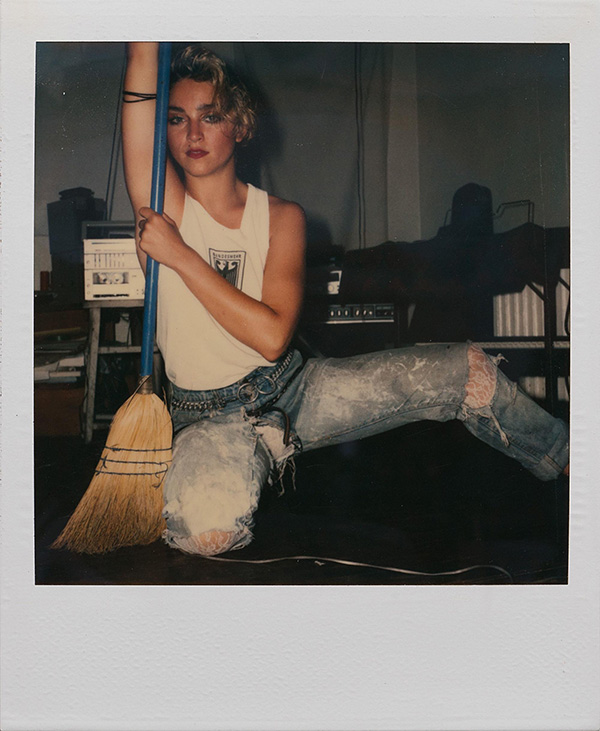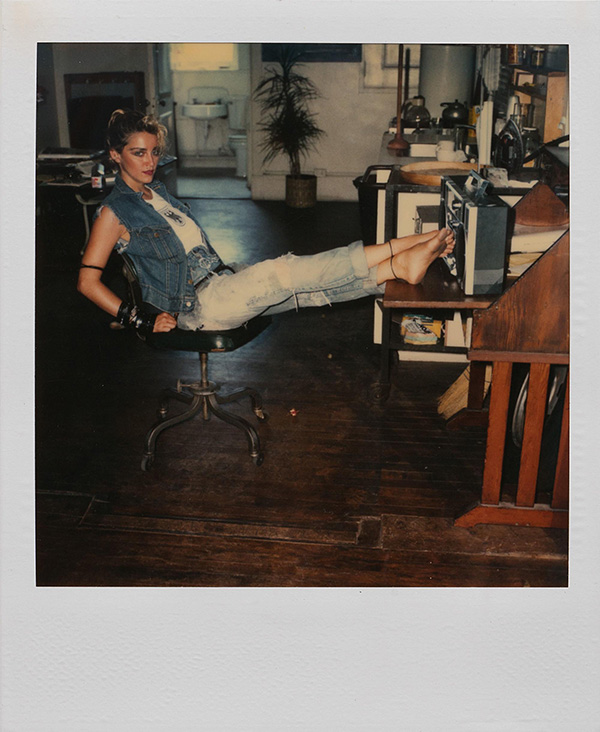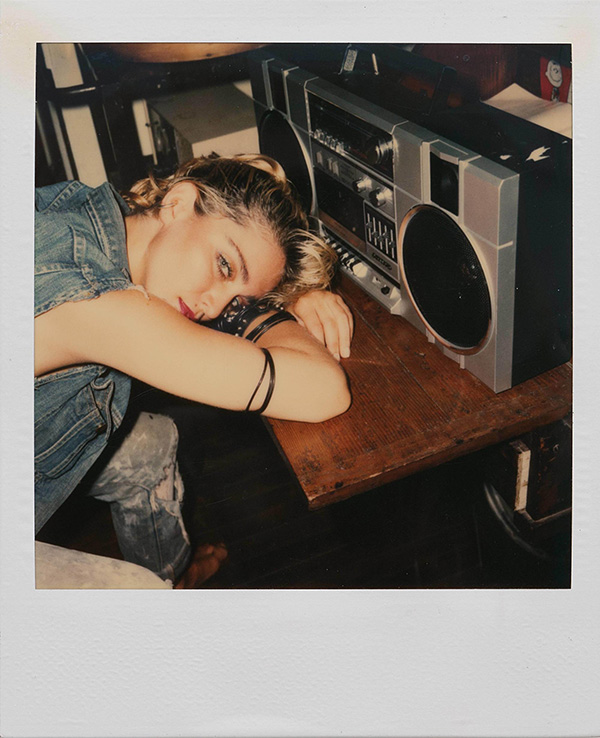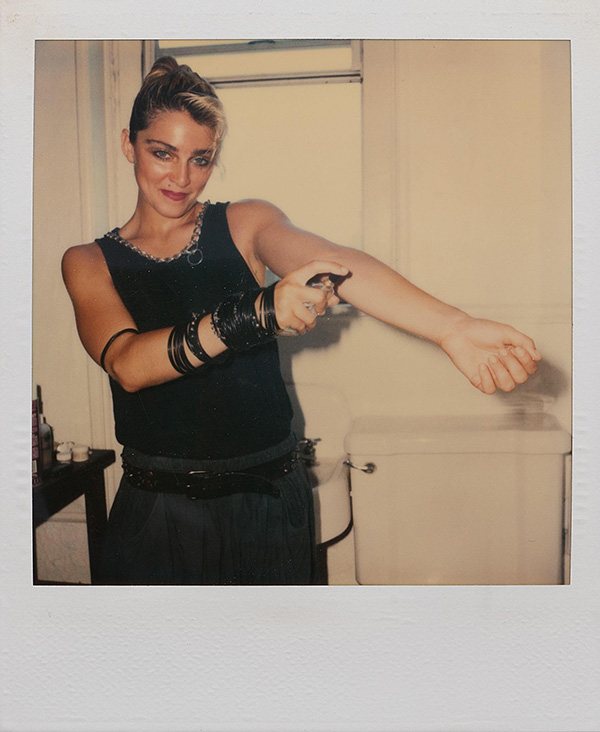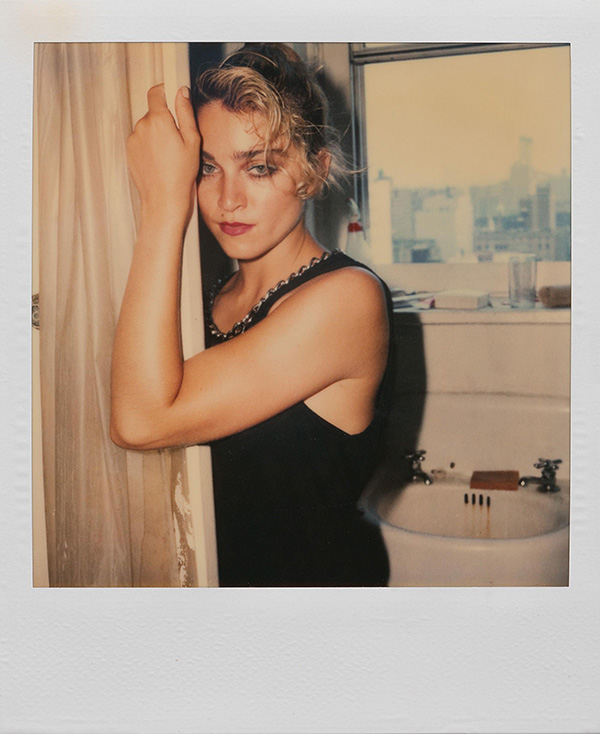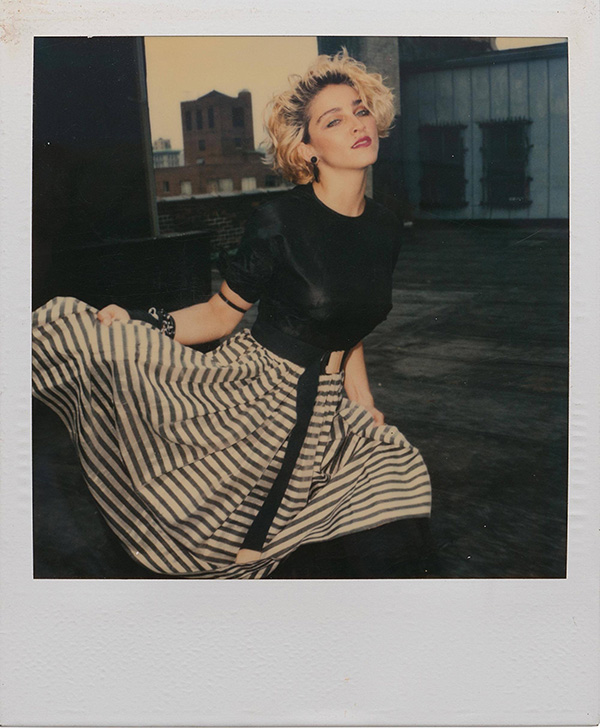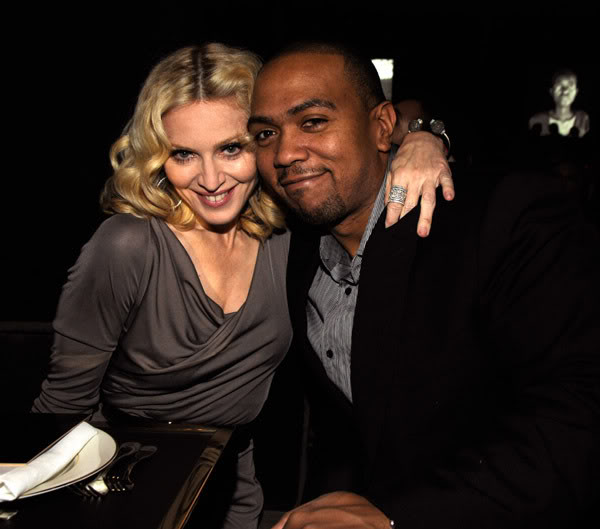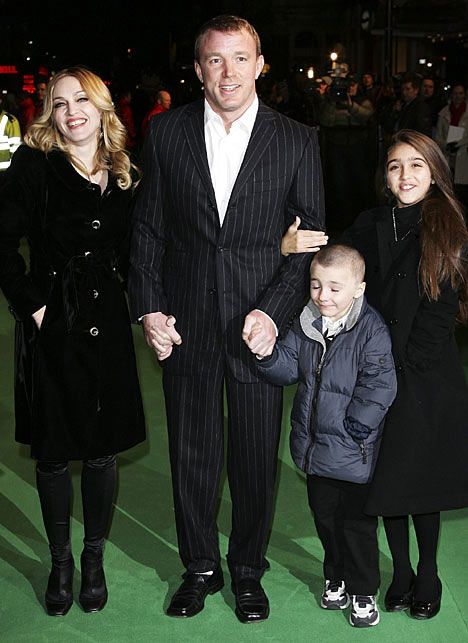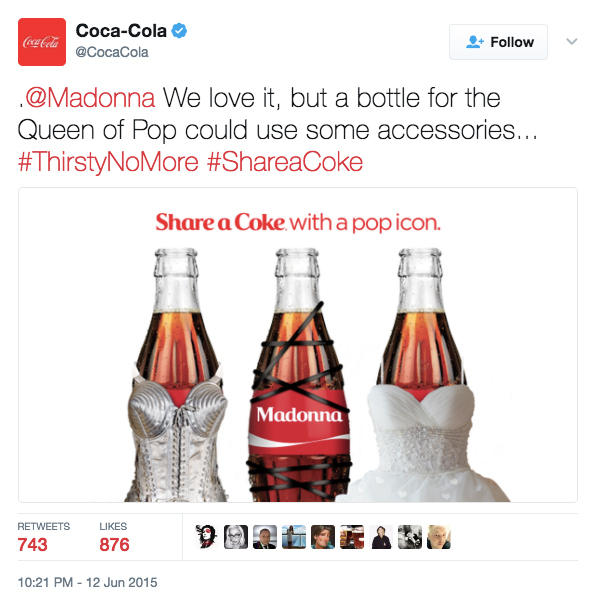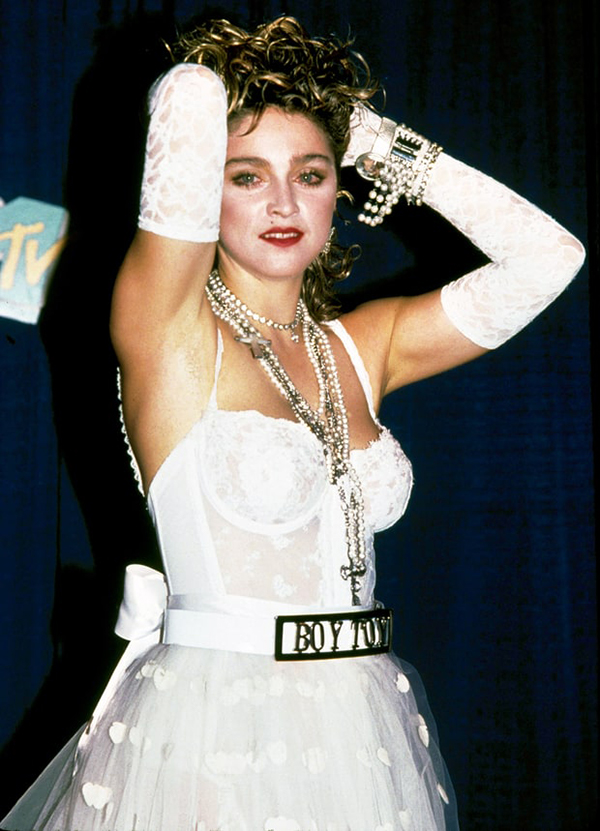| |
Madonna news - April 2017
← March 2017 | May 2017 →
Madonna at the MET Gala: which look can we expect?
Source: Mad-Eyes / Vogue - 29 April 2017Are you ready for the first Monday in May? While many in the UK will enjoy the bank holiday, for America and fashion-enthusiasts alike it is an entirely different thing: it is the MET Gala. This year's theme, for both the Metropolitan Museum of Art's annual Costume Institute exhibition and 2017 Met Gala, is Rei Kawakubo/Comme des Garçons.
First predicted by Suzy Menkes during Paris Fashion Week (following the presence of both Anna Wintour, editor-in-chief of American Vogue, and Andrew Bolton, curator of the Metropolitan Museum of Art’s Costume Institute, at the Comme des Garçons show), Rei Kawakubo will be the first living designer since Yves Saint Laurent in 1983 to be the sole subject of the Met's blockbuster fashion exhibit.
Madonna is expected to attend this year as well. Her fashionable appearances are always among the most talked about. Which look can we expect on Monday? Let's have a look at her outfits in the past years.
2016 MET Gala
Madonna left many stunned when she attended the 2016 MET Gala wearing a sheer black Givenchy gown. Accompanied by the brand's creative director Riccardo Tisci, she rocked the designer dress paired with knee-high boots and jeweled headpiece.
2015 MET Gala
In 2015, Madonna promoted her new Rebel Heart album by bringing producer Diplo as her guest and wearing a black Rebel Heart-emblazoned Moschino evening gown. She accessorized her look with a black cape, black leather gloves, and a rose gold crossbody evening bag.
2013 MET Gala
Givenchy's Riccardo Tisci gave Madonna a punk look at the 2013 MET Gala. Wearing shredded fishnet mini and matching tights she topped her bottom-less look with a black and grey tartan jacket embroidered with silver metal studs. Adding even more heavy metal, she also layered on a metal chain choker necklace and studded belt. Madonna was accompanied by her boyfriend Brahim Zaibat.
2011 MET Gala
Attending the 2011 MET Gala with manager Guy Oseary, Madonna looked stunning in a long blue evening gown by Stella McCartney. She accessorized with Cartier jewelry and Sergio Rossi heels.
2009 MET Gala
The 2009 MET Gala was Madonna's first red carpet apperance with boyfriend Jesus Luz. Dressed in a navy blue ruched Louis Vuitton mini dress, thigh-high black boots and the black fingerless gloves of old, she completed her ensemble with a teal-coloured hair piece tied around a top knot.
Strike a Pose: The ‘RuPaul’s Drag Race’ queens do Madonna dress-up
Source: Yahoo - 29 April 2017Last season on RuPaul's Drag Race, the contestants struck a pose in Madonna drag — and while they expressed themselves and gave good face, almost half of them inexplicably wore "Nothing Really Matters"-inspired kimonos for the challenge. Drag Race judge and avowed Madonna fangirl Michelle Visage was NOT amused. Neither was RuPaul. So for this week's Drag Race episode, the series staged a "shequel" and had the new Season 9 queens pay their own sartorial tribute to the "Dress You Up" queen of pop.
While a few Madonna-wannabes did dress nearly identically, again — thus garnering some fresh Visage shade — most of this season's material squirrels displayed true blonde ambition on the runway. Check out Reality Rocks' ranking of all 10 looks, from the luckiest star to a couple that did not justify RuPaul's love.

1. Valentina ('Sex' book, 1992)
This material girl rocked very little material onstage, but she did more with two strategically placed black censor bars than the other contestants did with yards of lace and tulle. Copying an iconic image from Her Madgesty's X-rated Sex book, Valentina gave new meaning to the term "read for filth."

2. Sasha Velour ("Erotica" video, 1992)
The judges were bound-and-gagging on this beautiful stranger's S&M eleganza. Sasha's edgy look hurt so good.
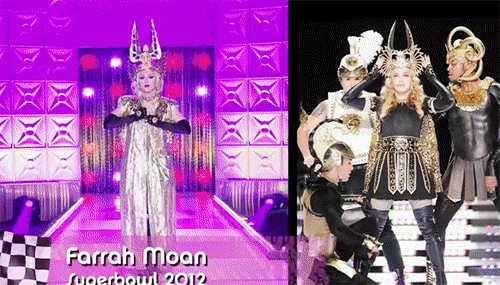
3. Farrah Moan (Super Bowl, 2012)
The most intricate and detailed of the bunch, Farrah scored a touchdown with this ornate Cleopatra look inspired by Madonna's Super Bowl halftime show. All that was missing from M.I.A. showing up and flipping the camera the bird.

4. Cynthia Lee Fontaine (Brit Awards, 2015)
On the surface, the kookoo cucu queen's matador costume seemed like a safe choice, but she elevated it to the level of genius comedy with her cape malfunction and Brit Awards-parodying tumble. Take a bow, Señorita Fontaine.
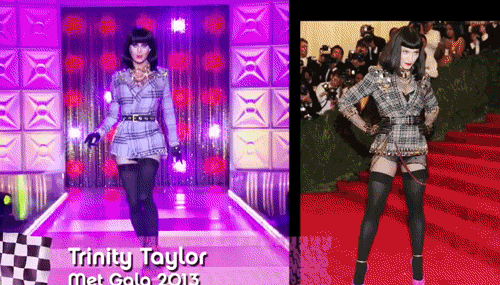
5. Trinity Taylor (Met Ball, 2013)
Madonna was the only fashionista who actually looked punk-rock at the supposedly punk-themed 2013 Met Ball, and Trinity did a great job as she slam-danced into the spotlight in a fierce recreation of Madonna's studded tartan Givenchy jacket, slashed fishnets, and geometric lob.

6. Alexis Michelle (Breathless Mahoney, 1990)
Season 9's resident theater queen served Old Hollywood realness in this curvy Dick Tracy getup. My one complaint is that the look was similar to the Golden Globes outfit she wore in this season's Lady Gaga-themed premiere episode, but Alexis certainly knows how to pull off classic peroxide-blonde glamour.
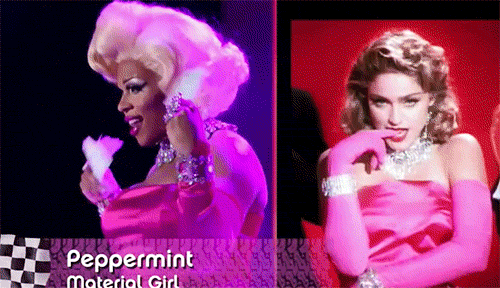
7. Peppermint ("Material Girl" video, 1984)
Peppermint's homage to "Material Girl" (which was itself an homage to Marilyn Monroe's "Diamonds Are a Girl's Best Friend" performance from Gentlemen Prefer Blondes) was spot-on. Every platinum hair and sparkly bauble was in place. Unfortunately, it wasn't that original, as we soon found out...
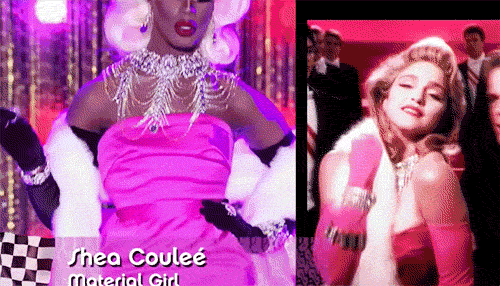
8. Shea Couleé ("Material Girl" video, 1984)
Shea was also pretty in pink, but her Like a Virgin-era ensemble wasn't as detail-oriented as Peppermint's — so Peppermint was the blonde that I preferred.
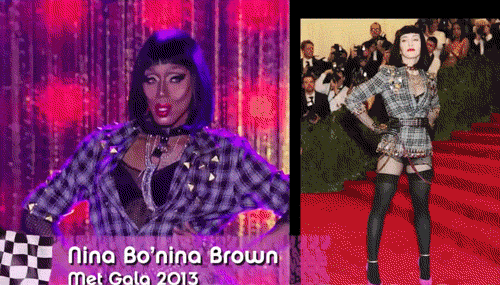
9. Nina Bo'nina Brown (Met Ball, 2013)
Nina tried to put a looser, more youthful hip-hop spin on Madonna's punk Met Ball outfit, but without the impeccable tailoring and structure of the original look, Nina couldn't measure up to Madge – or to Trinity Taylor, for that matter.
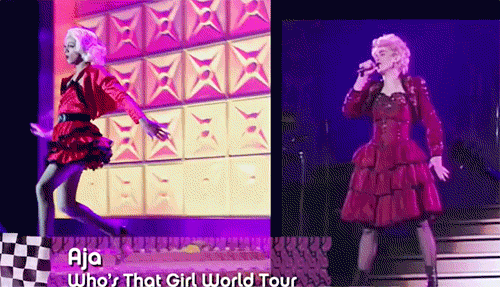
10. Aja (Who's That Girl Tour, 1987)
Who's that girl, indeed? Brooklyn queen Aja started off the season as one of my favorite and fiercest competitors, but her sloppy style, jealousy, and all-around bad attitude have caused her to slip in the ranks. This rayon costume looked cheap — like something straight off the rack of the Madonna section of a Halloween Superstore. Aja can do better than this.
We fact-checked the Madonna film script
Source: BBC - 28 April 2017Not for the first time, Madonna is on the war path.
The focus of her rage is Universal Pictures, who snapped up a script about the singer's early years in New York earlier this week.
Madonna sought out a copy of the screenplay, called Blonde Ambition, and immediately declared it to be "all lies".
"Nobody knows what I know and what I have seen." the 58-year-old fumed on Instagram.
"Only I can tell my story. Anyone else who tries is a charlatan and a fool. Looking for instant gratification without doing the work. This is a disease in our society."
Penned by first-time writer Elyse Hollander, Blonde Ambition topped last year's Black List, Hollywood's annual chart of the best unproduced screenplays.
The list has previously featured future Oscar-winners such as Spotlight, The Revenant, Argo and American Hustle - so it's no surprise that Universal nabbed the rights.
Two major producers have already been attached to the project, Michael De Luca (The Social Network) and Brett Ratner (X-Men), who himself directed Madonna's Beautiful Stranger video in 1999.
However, it's clear that the project doesn't have the star's approval.
In theory, that's not a barrier to the film getting made, but the script relies heavily on Madonna's music, including Like A Virgin, Everybody and Lucky Star.
If the singer vetoes their use, the project would essentially be dead in the water.
But how inaccurate is Hollander's script?
We read a publicly available draft to see how closely it stuck to Madonna's story.
While the arc is broadly true, Hollander compresses and condenses events, even creating composite characters to keep up the momentum.
Here's what's true, and what isn't.
True: Madonna was in a band called The Emmys
The first act of the script focuses on Madonna's pre-fame band The Emmys, which she formed with her boyfriend Dan Gilroy and childhood friend Stephen Bray, who went on to co-write Into The Groove, Express Yourself and True Blue.
Their name derived from Madonna's childhood nickname, and video footage of their scrappy garage tunes can easily be found online.
The film insists the group were a cheap knock-off of new wave pop band Blondie, but their sound was more indebted to Britain's ska and 2 Tone scenes.
Madonna can even be heard adopting a British accent in some of their early demos.
False: The Emmys were erased from history
One of the script's biggest fabrications was that Madonna and The Emmys had a deal with Sire Records and cut an entire album before Madonna took the songs, erased Dan's vocals and launched herself as a solo artist.
In reality, the band never got beyond making demo tapes; and many of the songs attributed to them in the film - including Borderline and Lucky Star - were written much later.
Madonna even paid tribute to Dan Gilroy when she was inducted to the Rock and Roll Hall of Fame in 2008.
"He lived in an abandoned synagogue in Queens," she recalled, "and he taught me how to play guitar.
"I practised those four chords that Dan taught me over and over and over again."
Partially true: Madonna worked in a Russian tea room
At the start of Blonde Ambition, Madonna is seen waiting tables at New York's prestigious Russian Tea Room.
While the star did work at the venue for two months, she was stationed in the cloakroom, and eventually let go for failing to adhere to the dress code.
"She was a hard worker, conscientious," said restaurant manager Gregory Camillucci in 1991.
"I got the impression that the one meal we fed her was the only food she was getting."
True: She dated her producer, Jellybean Benitez
Blonde Ambition's biggest sub-plot is Madonna's romance with dance producer John "Jellybean" Benitez, who produced her breakthrough single, Holiday, and remixed others, including Material Girl, Like A Virgin and Dress You Up.
They first met at the influential New York club Fun House, where, according to one observer, Madonna "walked right up to the DJ booth, grabbed him and kissed him".
After that, they dated for two years, during which time Madonna's career exploded - leading to inevitable tensions and the eventual breakdown of their relationship.
However, it's unlikely that their courtship included the sort of "romantic" dialogue Hollander provides in her script.
"You're the first Latin DJ to break out of genre in a heavily white industry and I'm a driven woman in [an] all boys club," says Madonna during one encounter. "We're both outsiders but I'm willing to work the system from within. Are you?"
True: (Most of) the things she said
Throughout the script, entire lines of dialogue are lifted verbatim from Madonna's interviews, including the pivotal quote: "It never occurred to me to get into this business and not be a huge success. I wanted the world to notice me, always have."
In fact, Hollander's reliance on archive clips caught Madonna out during her Instagram rant.
As an example of the script's inaccuracies, the singer singled out a line of dialogue on the first page, in which Madonna tells US TV personality Dick Clark: "I was born in Detroit. I'm a famed high school dropout."
"I was born in Bay City, not Detroit. And I did not drop out of high school. In fact, I went to University of Michigan," Madonna said.
But the interview Hollander quotes is available on YouTube - which might explain why Madonna later deleted her comments.
However, some of her quotes have been placed in a new context.
On page 58 of the script, Madonna tells Jellybean: "I always knew I was going to be a nun or a star. Spending six months in a convent cured me of the first one."
This superb (and untrue) piece of hyperbole actually comes from a handwritten letter Madonna sent to film director Stephen Lewicki, requesting an audition for his movie A Certain Sacrifice.
Partially true: She signed her record deal in hospital
One of the most well-worn Madonna stories is that Seymour Stein signed her to Sire Records in hospital, hours after having heart surgery.
In the script, this is all at Madonna's behest. So desperate is she to sign the deal that she frog-marches to his ward and practically puts the pen in his hand.
But Stein insists hewas the one who summoned Madonna to him.
"I was caught with dirty pyjamas with a slit up the back of my gown," he told Rolling Stone.
""I needed a shave and a shower. But I got it together to meet with her.
"When she walked in the room, I could tell she wouldn't have cared if I was like Sarah Bernhardt lying in a coffin.
"All she cared about was that one of my arms moved, that I could sign a contract.
"What I saw there was even more important than the one song I heard.
"I saw a young woman who was so determined to be a star."
Uncertain: The abortion
In Blonde Ambition's final scene, backstage at the 1984 MTV Awards, Madonna coldly informs Jellybean that she has aborted their child.
"I won't have to choose between my career and a family now," she says, not even deigning to make eye contact. "And that's how I want it."
Madonna has never suggested she was pregnant in 1984, and Hollander's claim would appear to be based on Christopher Andersen's salacious 1992 biography Madonna: Unauthorized (you can read an excerpt here).
However, Madonnahas spoken about having an abortion during the early years of her career on several occasions.
"You always have regrets when you make those kind of decisions," she told Times Magazine in 1996, "but you have to look at your lifestyle and ask, 'Am I at a place in my life where I can devote a lot of time to being the really good parent I want to be?'
"I think you have to be mentally prepared for it. If you're not, you're only doing the world a disservice by bringing up a child you don't want."
(A group of New York Film Students have filmed Blonde Ambition's final scene, should you be interested in watching an am-dram version of the movie).
True: The feud with Cher
"I think Madonna's vulgar and tacky," says Cher on the 83rd page of Blonde Ambition. "She's a flash in the pan at best."
Amazing though it may seem, the quote is real.
Madonna even responded to the comment in a 1984 interview with her future biographer J Randy Taborelli, saying: "Who knows tacky better than Cher?"
False: Madonna auditioned songwriters in a swimming pool
Half-way through Blonde Ambition, Madonna is desperately seeking a final song to complete her debut album. So she and Jellybean hold an open audition in an indoor swimming pool at the YMCA.
After a montage of dismal musicians playing dismal songs, funk duo Pure Energy walk through the double doors.
Singer Lisa Stevens and bassist Curtis Hudson (bizarrely renamed Richard Curtis in Hollander's script) nervously set up their instruments before playing what will become Madonna's signature song, Holiday.
Great story - but it never happened.
The band originally submitted a cassette demo of the song to Mary Wilson, of The Supremes.
When she rejected it, Holiday was passed on to Jellybean, who presented it to Madonna.
"The song still generates money," Curtis told blogcritics in 2006 .
"Can you live off of one hit? Yes, you can if you get the right hit. It can last you a lifetime. We've been living proof of that. If we did nothing else, the royalties from Holiday could support us."
True: She fell over at the 1984 MTV Awards
Madonna's most public mishap came at the 2015 Brit Awards, when she was yanked off stage by a cape.
But it had happened once before - at the first MTV Awards in 1984, when she lost a stiletto while walking down a 17ft (5m) tall wedding cake in her wedding dress (it could happen to anyone).
Although the incident plays a pivotal part in Blonde Ambition - has she lost the baby? - it was never as serious as the script makes out.
"I thought, 'Well, I'll just pretend I meant to do this,'" Madonna later said. "So I dove on the floor and I rolled around. And, as I reached for the shoe, the dress went up. And [my] underpants were showing."
The stumble-flash made television history and propelled Madonna to even greater heights. And that's where the film drops the curtain.
What's inside Madonna biopic 'Blond Ambition' and can she stop it?
Source: Hollywood Reporter - 27 April 2017If the Universal project does get greenlighted, it will have to survive the wrath of the Material Girl.
Most scripts on the Black List — an annual ranking of Hollywood's best unproduced screenplays, voted upon by the people who read them (many of them agency and studio assistants) — remain just that: unproduced.
But not always. Certainly landing in first place on the list doesn't hurt. Such was the case with Blond Ambition: The biopic from first-time screenwriter Elyse Hollander about Madonna's rise to fame earned 48 votes on the 2016 list, 13 nods ahead of the second-place entry from veteran scribe Dan Fogelman (This Is Us).
The script impressed Universal enough to snatch up the property, with two major producers — Michael De Luca and Brett Ratner — attached. Still, no director has yet been attached and the film is not yet an official green light.
Definitely not on board, however, is Madonna herself. The singer has posted several Instagram messages denouncing the project. In the first, posted just hours after The Hollywood Reporter broke the news of the project on Tuesday, she writes, "Nobody knows what I know and what I have seen. Only I can tell my story. Anyone else who tries is a charlatan and a fool."
On Wednesday, a copy of the script now in hand, her criticism crew more pointed and personal. "Why would Universal Studios want to make a movie about me based on a script that is all lies???" she writes. "The writer Elyse Hollander should write for the tabloids."
As an example of the script's inaccuracies, Madonna singled out a line of dialogue on the first page, in which Madonna tells Dick Clark in an interview on American Bandstand, "I was born in Detroit. I'm a famed high school dropout."
"I was born in Bay City, not Detroit. And I did not drop out of high school. In fact, I went to University of Michigan," Madonna counters. But Hollander took that exchange directly from the actual American Bandstand broadcast, as evidenced by this YouTube video. (Perhaps that is why Madonna later deleted the second Instagram post.)
If Blond Ambition does get greenlighted, it will have to survive the wrath of Madonna. For Universal, it could wind up being a headache not worth pursuing. It certainly won't be the first unauthorized biography to make it to the screen, but other recent notable instances — The Queen, The Social Network, Foxcatcher — were not reliant on a highly recognizable musical catalogue.
Figuring heavily into Blond Ambition's plot are such early Madonna hits as "Burning Up," "Everybody," "Borderline," "Lucky Star" and "Holiday" — all of them hit singles off her self-titled debut album from 1983. For Universal to include these songs, they would need to secure a sync license for the master recording (if they use the originals) and the music publishing rights.
Even if Madonna holds none of these rights herself, one prominent music lawyer estimates that "given her stature in the industry, she probably has an approval right" over the songs and could prevent them from use in Blond Ambition. The resulting film — a Madonna biopic without any Madonna music in it — greatly runs the risk of coming off like a big-budget Lifetime movie in the vein of Britney Ever After.
A second and far less promising tack would be to go after the script for defamation. But while there is plenty of material in Blond Ambition to which the Material Girl might object, calling it defamatory would be a legal stretch.
In one scene, she's depicted shoplifting in a drugstore, "stashing a toothbrush and some toothpaste in her backpack."
The script also suggests that Madonna stole her iconic look from another fixture on the downtown club scene, a character named "Bianca Stonewell."
And as her star rises, the screenplay suggests that Madonna ignores her then-producer and boyfriend, Jellybean Benitez, to cozy up to Prince.
"He tries to move past the bodyguard," the stage directions note. "Madonna, fully engrossed in a conversation with Prince, doesn't see him. Or does she?" (Italics Hollander's.)
And in the final scene, just moments after her triumphant performance of "Like a Virgin" at the 1984 MTV Music Video Awards, she callously informs Benitez that she aborted their child.
"I won't have to choose between my career and a family now," she says as she applies lipstick in a vanity mirror. "And that's how I want it." (The scene was shot by students at the Los Angeles Film School and uploaded to YouTube, making for an inadvertently hilarious piece of Madonna ephemera.)
Oddly enough, what could have been one of the most incendiary and emotionally wrenching chapters — Madonna's rooftop rape at age 19, something she spoke openly about in 2015 — is barely referenced in Blond Ambition.
"This might sound crazy, but when I first got to New York I wanted to believe the best in everyone," she tells Benitez. "Of course, it wasn't too long before someone took advantage of that. Took advantage of me..."
"Wait ... Do you mean..." Benitez interrupts.
"I don't want to get into it," she replies.
For now, Madonna is not speaking out further on the subject, having passed on a request for comment. Hollander, too, did not respond to a request for comment; her Twitter feed was recently made private.
Madonna is not happy with biopic 'charlatans'
Source: Instagram - 25 April 2017Well that didn't take long!
Only hours after it was announced that Universal is planning a biopic, titled Blond Ambition, about Madonna's early years and rise to fame, Madonna has reacted to the news on Instagram. And clearly she is not that fond of the idea.
Australian Channel 9 to broadcast Rebel Heart Tour May 8th
Source: YourTV, MadonnaAustralia - 25 April 2017The Rebel Heart Tour will be broadcast on Australia's Channel 9 on May 1st at 9pm.
The show, which was mostly recorded in Sydney, was first shown on American cable channel Showtime on December 9, 2016.
An official release date for the DVD has yet to be confirmed, but Madonna earlier suggested it might be released on her birthday on August 16th. Recently, she also posted they were still editing the Tears of a Clown show, which will feature as bonus material.
UPDATE May 6: After postponing the broadcast to May 8, it has now completely disappeared from the programming...
Madonna biopic 'Blond Ambition' lands at Universal (Exclusive)
Source: Hollywood Reporter - 25 April 2017Lucky star: Elyse Hollander's script was No. 1 on the Black List in 2016. Michael De Luca and Brett Ratner are producing.
Universal is getting into the groove for a Madonna biopic.
The studio has picked up Blond Ambition, Elyse Hollander's script that topped the 2016 Black List, the industry ranking that tracks Hollywood's most-liked unproduced screenplays.
Michael De Luca, who produced Fifty Shades of Grey for Universal, is attached to produce along with Brett Ratner's RatPac Entertainment. John Zaozirny of Bellevue Productions also will produce.
The story is set in early 1980s New York as Madonna Louise Ciccone works on her first album, struggling in a business that treats women badly, while also dealing with a burgeoning love life and the first hints of fame.
Madonna moved to New York from Michigan in 1978 to pursue dance but segued to singing and writing songs. After failing at a rock band, she switched to dance and pop. After achieving some success with a few dance singles, she began work on her debut album,Madonna, which was released in 1983. The album yielded hits "Holiday," "Borderline" and "Lucky Star," and set the stage for her ground-breaking Like a Virgin album.
Blond Ambition is the debut script for Hollander, who worked as an assistant to Alejandro G. Inarritu while he made Birdman, and Fresh Off the Boat co-executive producer Kourtney Kang. She is repped by WME, Bellevue, Ryan Pastorek and Robby Koch of Hansen Jacobson.
De Luca is coming off of producing this year's Academy Awards and will produce next year's broadcast as well. Ratner's RatPac recently announced a partnership with Len Blavatnik's Access Entertainment.
Universal executive vp production Erik Baiers and director of development Chloe Yellin will oversee production for the studio. Lucy Kitada will help oversee for De Luca Productions.
Geena Davis spills 'League of Their Own' secrets on 25th anniversary
Source: USA Today - 23 April 2017Geena Davis was not aware she was making screen history as baseball standout Dottie Hinson in 1992's A League of Their Own with co-stars Tom Hanks, Madonna, Lori Petty and Rosie O'Donnell.
When Hanks, as the gruff manager of the fictional team from the first professional all-women baseball league, called out to one of his despondent players, “There's no crying in baseball,” it didn't strike Davis as an immortal moment.
“We knew it was hella funny,” Davis, now 61, recalls. “But I didn't know that was going to be a classic. That line is a signature, right up there with ‘Hasta la vista, baby.'"
League has earned its place as one of America's best sports comedies, selected for preservation in the National Film Registry by the Library of Congress in 2012.
As the film celebrates its 25th anniversary on July 1 (with a new special edition Blu-ray out now), Davis recounts her memories from the League set.
Her audition was simple: Director Penny Marshall insisted League actors truly play ball. Davis' audition consisted of demonstrating her baseball prowess in Marshall's backyard.
“(Marshall) wanted to make sure I could throw a ball, so that happened,” says Davis. “I threw the ball to her, competently got it to her, she caught it and said, ‘Okay.' That was the whole audition.”
Without an athletic upbringing, Davis trained intensively to flesh out her game and ultimately impressed the real baseball coaches onset.
“When the coaches would say, ‘You have real untapped athletic ability' it was like, ‘Oh my God, I am coordinated.' It just took me (until I was) 36 to find that out.” (She would go on to compete at the U.S. Olympic Trials in archery in 1999, two years after taking up the sport.)
Davis excelled at batting and that stare. “I wanted people to say ‘Uh-oh' when I came to bat.”
Pitches were hard, balls were soft: Special precautions were required for close-up batting shots. Sponge-filled balls were used — not for the batters, but the crew.
“You're actually hitting in the direction of the camera crew,” says Davis. “For close-ups, those balls were squishy. They looked like real baseballs, but they were all spongy inside so we wouldn't clock anyone.”
Davis did the on-camera split: As catcher, Hinson pulls an acrobatic split when catching a foul ball, which Davis performed.
“Penny asked if I could do a split. I said to put it later in the shooting schedule to give me time to work up to it. It's hard to learn that quickly. But I did," says Davis.
She soaked in a hot tub to loosen up before the scene and nailed the split.
“The thing I did not do was get up from it. My character does a Chuck Berry split and then hops right back up,” says Davis. “There was no popping up happening. I was stuck there and had to be helped up.”
Madonna was a question mark: Davis admits she wasn't sure what it would be like to work with Madonna, then in her prime.
“She was Madonna. We wondered if we were going to be able to talk to her. Was she going to have an entourage? Were they going to put up walls around her where she stands?” Davis recalls.
Ultimately, Madonna was a team player who trained hard and insisted on sliding head-first into bases. “That was painful. But she was so game. She was a trooper,' says Davis.
Ageing under the spotlight
Source: Cherwell - 23 April 2017Sophie Burdge condemns ageism in pop culture and our generation's obsession with beauty.
The film industry has been wracked with controversy in recent years, with accusations of discrimination flying left, right and centre. From the #oscarssowhite trend of 2016 to Patricia Arquette calling out Hollywood's wage disparity in her Oscar acceptance speech in 2015, we are all finally starting to wake up to the fact that the seemingly perfect and polished celebrity world is just as infiltrated with prejudice as every other aspect of society. Despite our societal tendency to position our celebrity idols under a microscope, it is only in recent years that issues such as ageism have really been highlighted in the media.
The very nature of celebrity is rooted in admiration, all too often aesthetic admiration. When we watch a film or listen to music, we often don't recognise the complexity of the people involved, instead reducing them to a simplistic idea of straightforward beauty. Ageing complicates this admiration. We are used to categorising celebrities as someone to emulate, but when the first grey hairs and laughter lines appear, suddenly they become a bit less god-like, and all too human for our liking.
Both Hollywood and the music industry are guilty of perpetrating these ideas. Madonna is a prime example of a woman who can seemingly do nothing right these days. Her onstage kiss with Drake is an obvious illustration of the double standards she faces. While other factors are naturally at play when considering the incident—principally Drake's lack of consent—the point remains that a lot of the visceral disgust voiced on Twitter and other social media platforms was related to the age gap between Madonna and Drake. While in theory we reject the convention which teaches us to be appalled by a relationship between an older woman and younger man, the legacy of such a heavy cultural influence is hard to shake.
Madonna resolutely refuses to relinquish her sex appeal, and rightly so. She was among the first to embrace her own sexuality at a time when few female artists did, and as a result has become a feminist icon. Rather than retreating to ballads and black dresses like many singers of her age, she continues to joyfully prance around in bodysuits and leotards, throwing her legs above her head in a way which many in their twenties would envy. Yet her performances are often figured as grotesque, a laughing stock, or a warning to those also considered ‘over the hill'.
In 2015, Madonna went so far as to accuse BBC Radio 1 of ageism for their refusal to add her new single to their playlist. The response from the station was that they were trying to lower the average age of listeners, and that most Madonna fans were in their thirties and forties. A fair response perhaps, yet even on Radio 2, a station aimed at over 35s, Madonna's single was only begrudgingly added to the C playlist, meaning that its airtime was minimal. Paradoxically, it was pointed out that Radio 1 often play songs by older artists, listing David Guetta (49) and Paul McCartney (74) as examples. For starters, it is significant that both of these artists are male, but also that the only Paul McCartney song that has been featured on the Radio 1 playlist in decades is ‘FourFiveSeconds,' a collaboration with Kanye West and Rihanna—two much younger artists.
The backlash to Madonna's complaint reflects the all too conventional negative attitude towards assertive women. While undeniably a problem for all women, particularly in the workplace, the stereotype of subservience affects older women to an even greater extent. Being a ‘Girl Boss' is becoming trendier and trendier, as young women are encouraged to go after the careers and lifestyles that they deserve. However, the aspirational image of the ‘have it all' career woman is notably restricted to the young and glamorous. While the idea of a young and stylish business woman demanding the raise she deserves fills most of us with ‘you go girl'-esque admiration, a woman in her fifties doing the same thing would likely provoke discomfort in many. While Jennifer Lawrence was applauded for her open letter criticising wage disparity in Hollywood, Madonna's claim that her poor chart performance was the result of discrimination was treated as the whining of an old woman who can't let go.
It is perhaps this differing standard applied to men and women which is the most disturbing aspect of ageism in our society. In a recent interview on Radio 2 promoting their new film ‘Going in Style,' Michael Caine and Morgan Freeman both expressed their happiness at the number of roles they are still receiving in their seventies and eighties respectively. They proclaimed it as a sign that ageism in Hollywood is really not such an issue, with Caine even exclaiming triumphantly: “I'm not sitting round watching Coronation Street!” While I'm glad that Freeman and Caine are continuing to have their talents recognised and appreciated well past conventional retirement age, what the industry really needs is respected artists such as them to acknowledge and call out disparities. Their blindness to the fact that they are the exception, rather than the rule, not only excuses, but perpetrates harmful views.
Meryl Streep is one of the few high profile individuals in the film industry who does actively call out the ageism and sexism that she experiences. Although some may be sceptical of Streep's claims of discrimination, due to her continuing relevance in Hollywood, she is vocal about how much harder she has had to fight for these opportunities since turning forty. In 2011, she confessed to Vogue Magazine that upon exiting her thirties she was only offered three roles–all witches–astutely noting that “once women passed childbearing age they could only be seen as grotesque on some level”. But unlike Freeman and Caine, who refuse to acknowledge the issues present in their industry, Streep is actively trying to solve the problem. She is helping to fund a screenwriting lab for women over forty, in the hope that diversifying representation behind the camera will propagate a similar growth onscreen.
While it is of course true that male actors will often face a decline in opportunities as they age, perhaps restricted to roles such as ‘senile old man' or similar, it is undeniable that female actors suffer this fate to a much greater degree. The collective decision taken by film industry professionals, and even viewers themselves, that a woman is no longer at her peak attractiveness, epitomises the very objectification which the majority of us so vocally condemn. The recent Women's Marches across the world demonstrate that feminism is a very prescient issue, and one being taken seriously, so why is that as a society, we still enable and encourage ageist attitudes towards women in popular culture? The fact is that films with female leads over forty don't make as much money at the box office. Of course there are notable exceptions such as The Best Exotic Marigold Hotel, but movies fronted by lesser known older actors often fall flat. Although our tastes are obviously moulded to a degree by the film industry itself, the influence goes both ways, and so by supporting films featuring older actors, we can help to foster a culture in which ageing is not something to be dreaded in our own lives, or disgusted by in others' lives.
It is the idea of the female actor being intended for titillation which perpetrates this problem. Of course we are all guilty of objectifying our favourite celebrities to a certain degree, but this sense of ownership goes much further than teenage girls wondering what it would be like to kiss Zayn Malik. There is a cultural expectation that a female celebrity owes her followers something, her sex appeal translating into a currency of success. While male celebrities become ‘legends' and ‘icons' as their conventional attraction wanes, women struggle to make a similar transition. Their value is irrevocably tied to their appearance, and once their appearance ceases to be pleasing to their audience, the unspoken contract between performer and viewer is infringed.
And it's not as if this objectification is even purely sexual. The attitudes of straight women towards their favourite female celebrities can often be just as harmful, particularly in the Instagram age, in which we can follow and fawn over their every move. The rise of social media has fostered trends such as the ever present ‘#goals' hashtag, an idea which has always existed, but has only recently been explicitly named. It's more than just petty jealousy. In fact, it's taking active pleasure in the beauty, glamour, or success of someone you admire. But when your favourite female celebrity becomes a bit less #goals and a bit more grizzled, then why bother watching them anymore?
After all, whatever the content of a movie, the primary goal is ultimately escapism. For many viewers, this manifests itself in an appreciation of the seemingly perfect lives of its stars, as we perversely revel in the levels of glamour and beauty which our own lives can never hope to attain. Such admiration in itself is not necessarily harmful—society has always orientated itself by its idols. However, it does propagate the idea that ‘perfection' and hence, happiness, is only attainable between the ages of twenty and forty.
As a society we still consider women, especially beautiful women, to be flat and one-sided, with little more to offer than being aesthetically pleasing. Whether consciously or subconsciously, we all have an inherent discomfort with women who are perceived as ‘unattractive', a bias which we must do our best to fight. Perhaps the unpopularity of older female celebrities simply reflects our own fears of ageing—the idea that if we don't see it reflected in the media then we can pretend it will never happen to us—but this attitude in itself is deeply harmful. The infiltration of ageist attitudes in popular culture reflects a wider obsession with beauty, and a concerning cultural shift towards superficiality. Prejudice in the film and music industries makes a significant contribution to this, filtering down to us, and infiuencing our own ideas of beauty and happiness. Perhaps the first step to developing more healthy attitudes towards our own appearances is to appreciate the performances of older people in the film and music industries.
Choreographers Wang Ramirez: 'Working with Madonna was intense, exciting and powerful'
Source: MSN / France24 - 21 April 2017Gravity-defying dance duo Honji Wang and Sébastien Ramirez speak to Eve Jackson about choreographing for Madonna, reflecting society in their work and fusing their backgrounds of German, Korean, French and Spanish on stage.
Wang & Ramirez choreographed several performances of Madonna's Rebel Heart Tour. They talk about the collaboration from the 6'13 mark on in below video.
'A League Of Their Own' starring Madonna, Tom Hanks, Rosie O'Donnell - turns 25!
Source: iHeart80s - 21 April 2017'A League Of Their Own' starring Madonna, Tom Hanks, Rosie O'Donnell - turns 25! And here's a few things you might not have known about the classic film.
Slant names Erotica among best albums of 1992
Source: Slant Magazine - 20 April 2017In my introduction to Slant's list of the 100 Best Albums of the 1990s, I described nostalgia for the decade as “an idealized vision of a time when Bill Clinton was the fresh, young Democrat on the block, beepers were the hottest new tech items, and every major record label and Top 40 radio station was scrambling to discover the next big alternative to run-of-the-mill pop.” I went on to lament: “It's human nature to look back on things with irrational fondness and nostalgia, overlooking the bad and romanticizing the good. But while the '90s had its fair share of 'crap,' it's hard to deny that the 'good' was exceptionally good.” So good, in fact, that we decided to dust off our lovingly curated list of over 400 albums to compile individual Top 10s for each year of the '90s. Many of these titles are already widely—and rightfully—celebrated, but these lists also give us the opportunity to honor some typically overlooked gems. Sal Cinquemani
10. The Pharcyde, Bizarre Ride II the Pharcyde
9. Prince and the New Power Generation, Love Symbol
8. Beastie Boys, Check Your Head
7. Annie Lennox, Diva
6. Tori Amos, Little Earthquakes
5. Tom Waits, Bone Machine
4. Pavement, Slanted and Enchanted
3. Dr. Dre, The Chronic
2. Madonna, Erotica
1. R.E.M., Automatic for the People
No Madonna album was ever met with a louder backlash or was more rampantly misrepresented than this dark masterpiece, so you know it was doing something right. Released on the tail end of AIDS hysteria, Erotica is far from the opus to guiltless sexual fulfillment it—and its even more ridiculed accompanying tome Sex—was made out to be. Though there's no doubt it espouses taking joy in physical pleasure (“Let me remind you in case you don't already know/Dining out can happen down below”), no album seems more empathetically haunted by the act's countless side effects (i.e. Bad Girl, Thief of Hearts, a purposefully monotonous house cover of Peggy Lee's Fever). Underneath Madonna's bondage getup and Shep Pettibone's oversized drum tracks beats a truly pained heart. Henderson
66 long-lost polaroids of Madonna in '83 show a mega star on the verge
Source: i-D - 18 April 2017In June 1983, Madonna was an ambitious 24-year-old getting some heat on the club charts. When photographer Richard Corman met the young singer, she served him bubblegum and espresso on a silver tray at her beyond-bohemian walkup on East Fourth Street between A and B. It was, as he puts it, "literally right before she stepped out and ran into the stratosphere." The month after they took some casual casting Polaroids, she released her debut album, Madonna, which produced three top-ten hits (Holiday, Lucky Star, Borderline). One year later, she was writhing around a wedding cake in her career-making MTV VMA performance of Like A Virgin. But when Corman took these gorgeous, stripped-down SX-70 Polaroids, she was still DJ Jellybean Benitez's girlfriend, the good dancer from Funhouse and Danceteria, and a hustler who paid the rent by waitressing and posing nude for art students. As she wrote of that time, "I felt like a warrior plunging my way through the crowds to survive."
Richard Corman was well-connected in the early 80s. He had assisted Avedon, and his mother Cis was a casting director who worked on films like Raging Bull and The Deer Hunter. When Corman photographed Madonna, he was also taking pictures of Keith Haring in Soho and Jean-Michel Basquiat at his Great Jones Street studio. But nothing prepared him for the young woman who looked to him like she "was going to rule the world." After 30 years of languishing in a warehouse, the 66 polaroids will finally get their due this fall as a book and an exhibition. Corman shares the story with i-D.
How did these polaroids come about?
These are images that I shot in 1983. What makes them so charming and special to me is actually the connection to my mother. She had introduced me to Madonna in the spring of '83, when she was casting a movie called The Last Temptation of Christ, with Martin Scorsese. They auditioned Madonna for the Virgin Mary. As it turned out, Madonna never got the part, but she and I met each other at the time when I was working at Avedon Studios. I was looking constantly for interesting people to photograph. I had never met anyone really like her. She was original.
The Polaroid shoot came a bit later, when my mother was developing a niche musical called Cindy Rella. Madonna was actually at her brother's apartment, and I needed to send [casting] pictures to Warner Bros ASAP. We didn't do anything digitally or on an iPhone back then, we had Polaroids. So I shot about 66 Polaroids. We put together a book with a script for a treatment, and the casting. Michael Jackson or Prince would play the prince, Aretha Franklin was going to play the wicked stepmother. As it turned out, the movie never got made and the script and the 66 Polaroids were, I thought, lost for 30 years. Recently when I was going through my warehouse, cleaning it out from the farthest corner, my mouth was wide open to find that these images were just sitting there. In perfect condition.
If we did these pictures today there would be 30 people standing in that apartment. But it was just me and her, it was so simple. She was so accessible, funny, and sexy. She was so cool and had such charisma. So we started with the few pictures where she was cleaning the house as Cinderella, and then she's getting ready for the ball. She went out and I think she took two hours to find that dress at some vintage store. At the time, she was kind of a local phenom.
I'm not necessarily a Madonna fan, but I'm certainly a fan of her determination, her spirit, and her energy. The pictures today feel a lot more relevant than they did back then. She was always relevant, of course. Just the way she was dressed, her hair, her makeup. Everything about her style and her swag was just 21st century. Between the denim and the red lips, and the cat eyes, the dark roots. Everything about her was now.
So she styled herself and did her own hair and makeup?
Totally. She was always in control. She knew exactly the way she wanted it to look. That evening, she met me and my mother and father up at this place on the Upper West Side where every New York City actor hung out. She walked in and she just stopped traffic. Nobody looked like her! She was a visionary in life, and she was certainly 100% original.
And your mom, Cis Corman, was a casting director?
Yes, she was a casting director and she later became a producer at Barbra Streisand's company. The thing that makes this really special for me is that she's suffering terribly with Alzheimer's now. She's 90. This is really an homage to her. None of this would have happened without our collaboration.
When did you start taking pictures?
I started taking pictures shortly after I was with Avedon in '83. I never studied it, I was prepared to go into graduate school for psychology. I took a year off and photography kind of fell into my lap, just because I needed a break. Then I fell in love with it, and took a shot with it and decided that this is where my heart was. The experience at Avedon certainly changed my life.
What was it like working with Avedon?
Life-altering in the best way. You were around someone who was just incredibly passionate, smart, and his entire life revolves around his work. He was brilliant, he was generous, selfish, but I spent a lot of time traveling with him. One of the projects I worked closely with him on was In The American West. So I spent two summers with him traveling out there. It was just kind of mind-altering. We talked about photography and art.
How do you think Avedon's work has influenced your own?
The most important thing about Dick's work was the eyes of his subjects, and the ability to see behind their eyes. He allowed them to tell their own stories. For me, the pictures that mean the most are the ones where I see something behind people's eyes. Where they're allowed to tell their own story.
So what's Madonna's story from these images?
"I will be on top of the world. I will rule the world. Nothing will stop me, and I will go through anybody to get to where I'm going." That was absolutely the language. It was so real and so natural. Nothing seemed pretentious. When I first met her and went to her apartment, she had to show me up the stairs because it was a building that was full of thugs. They protected her. She said, "Richard, you can't come into the building until you tell me you're here so I can tell the guys downstairs." She was the pied piper of the neighborhood. People would come to her apartment to have pizza, go to the roof to sing and dance. She embraced it, and the city was really rough back then.
Richard Corman's '66 Polaroids' will be out this fall from NJG, accompanied by an exhibition.
Timbaland about his collaboration with Madonna: "It was very hot... literally"
Source: The Quebec Times - 16 April 2017On the occasion of the release of The Pop Game, the new musical show he produces, Timbaland reveals behind the scenes the creation of three songs of stars on which he worked.
That said launching a new show, called promotion and interviews. The opportunity for the successful producer Timbaland to say more about the back of the decor of the profession of producer. He reveals my behind-the-scenes recording of some of the famous songs he has worked on.
4 Minutes from Madonna
The atmosphere warmed up when Madonna partnered with Timbaland and Pharrell Williams … literally. Indeed, the queen of pop hates air conditioning and usually raises the temperature during her concerts or when recording her studio albums. She is very afraid of losing her voice because of the cold. “It was really hot,” Timbaland recalls, pointing out that it was the star's only requirement. Madonna has her feet on the ground. ” Before concluding:” It's incredibly honest most of the time – “It's okay, no! “- She goes straight to the goal but remains very pleasant in the work and very concentrated. ” A recipe that seems to pay.
Madonna teases about her new movie Loved
Source: Instagram - 12 April 2017In her interview with Harper's Bazaar, Madonna has spoken about her new movie Loved, though it remains unclear in which stage this project is right now.
On Instagram she posted a Gucci bracelet with the word 'Loved', while commenting "Coming to a theatre near you".
Guy Ritchie asks Madonna to preview his new film
Source: Radar Online - 12 April 2017Guy Ritchie and Madonna have put their recent custody battle over Rocco behind and the two are so close again that they've even hit the movies together!
According to an insider, Ritchie, 48, recently invited the 58-year-old singer to a private New York City screening of his new movie King Arthur: Legend Of The Sword.
"It's amazing, but for all his problems with her over the years he'll always respect her opinion as an artist and a trendsetter," the source explained to Radar.
"He's never gotten out of the habit of showing her one of his movies before anyone else and getting her opinion of it."
As Radar reported, the two locked horns over their 16-year-old son Rocco's decision to go live with the director in London rather than stay in New York City with his mom, leading to a spate of bitter custody disputes in court.
However, when it comes to art, Ritchie still respects, and even seeks out, what Madonna has to say.
"She always tells the truth and in this case, it was crucial for him to get an unbiased opinion — he's hoping to spawn a franchise from this film," said the insider.
"He's trying to tap into a bigger family audience with this one than with anything else he's done, including the Sherlock movies."
Shep Pettibone sues Warner over Vogue royalties
Source: TMZ - 12 April 2017The famed producer behind Madonna's Vogue says he's getting the short end of the stick -- to the tune of half a million bucks -- because the record label's out for payback.
Shep Pettibone, producer extraordinaire -- who's worked with Madge, Janet Jackson, Paula Abdul and a ton of other artists -- says WB Music Corp owes him a ton of back royalties for the 1990 mega hit.
It appears everything was fine up until 2012 ... when Shep and WB were sued for allegedly jacking Vogue from someone else. In his lawsuit, Shep says they both came out victorious in that case, but the label spent a ton on lawyers -- more than $700k, according to docs.
The mega producer says WB's been withholding royalties since then to cover that massive legal bill. Translation: we forked out the dough to defend your song ... now you owe us.
Shep ain't buyin' that theory though, and says his contract with the label doesn't give them the right to hold back his Vogue dollars.
He believes he's been screwed out of as much as $500k, and wants a judge to force WB Music to hand over the loot.
Coca-Cola gives accessories to Queen of Pop
Source: Twitter - 7 April 2017It shouldn't come as a surprise that Coca-Cola is loving the beef between Madonna and Pepsi. They responded on Twitter to Madonna's support for Coca-Cola by offering accessories to the Queen of Pop, eagerly attaching their marketing hashtags.
Many other media loved the new beef between Madonna and Pepsi. Here's a small selection:
"Why Madonna is drinking in the Pepsi controversy"
- CNN
"Madonna Mocks Kendall Jenner Pepsi Ad Fiasco By Recalling Her Own Cola Controversy"
- Billboard
"Madonna Reignites 28-Year-Old Pepsi Beef With Kendall Jenner Jab"
- Elle
"Madonna Is Totally Trolling Pepsi Over Its Kendall Jenner Ad"
- Time
"Madonna Shades Longtime Enemy Pepsi Following Kendall Jenner’s Controversial Ad"
- Cosmopolitan
"Madonna takes a sly dig at Kendall Jenner’s Pepsi disaster"
- The Sun
Madonna joins outrage over absurd Pepsi commercial
Source: Instagram - 6 April 2017Pepsi has come under fire for their new commercial, which features Kendall Jenner solving some kind of protest march by handing a Pepsi to one of the police officers. Many are protesting that the soda giant just wants to capitalize on the current political situation.
Madonna also posted the video with a comment, expressing her disappointment.
Obviously, we all know the story between Madonna and Pepsi commercials. In another social media update, Madonna took a jab at Pepsi with a picture dating from 1999 showing her holding a can of Coca-Cola instead.
More from People.com:
In January 1989, the singer inked a $5 million endorsement deal with Pepsi that led the company to release a two-minute television ad and featured her singing and dancing.
The fairly innocuous ad reached an estimated 250 million viewers in over 40 countries, but was subsequently revoked in April 1989 after it generated controversy when Madonna premiered the full-length music video for Like a Prayer on MTV the following day. The video's imagery, which included burning crosses, stigmata and the seduction of a saint, drew the ire of religious groups and customers, who assumed it was part of the Pepsi ad.
At the time, the Vatican condemned the video and religious groups threatened to ban the commercial and boycott Pepsi products. Not only did Pepsi eventually pull the commercial but the company also canceled Madonna's sponsorship contract.
Fast forward to present day, a variety of people from Lena Dunham to Martin Luther King, Jr.'s daughter have weighed in to call Jenner's Pepsi ad tone-deaf.
In her "Live For Now Moments Anthem" commercial, the model and Keeping Up with the Kardashians reality star leaves her photo shoot behind to join a march before handing a police officer a can of Pepsi, causing her fellow protesters to erupt in cheers as he takes a drink.
Many detractors accused Pepsi of blatantly appropriating the spirit and imagery of the anti-Donald Trump resistance, Black Lives Matter and other movements in order to sell their product.
In response to the backfire, Pepsi defended the ad in a statement: "This is a global ad that reflects people from different walks of life coming together in a spirit of harmony, and we think that's an important message to convey."
Guy Oseary (kinda) invites Pharrell back in the studio
Source: Instagram - 6 April 2017Pharrell Williams turned 44 years old yesterday. Among the many people congratulating him with his birthday was Madonna's manager Guy Oseary who cheeckily said Pharrell should hit the studio again with "the blonde".
Most likely, Oseary didn't mean much with the tweet, since work on Madonna's next album hasn't even started yet. But you never know if Madonna and Pharrell might work again in the future.
Pharrell co-wrote and produced part of the Hard Candy album. He also had a recording session with Madonna for Rebel Heart but none of his demo tracks (Back That Up, Take A Day, Take It Back,...) ended up on the album.
Madonna’s Wildest Moments: Relive the Queen of Pop’s shocking statements, provocative performances and more!
Source: US Magazine - 5 April 2017She's always been a Rebel Heart. Madonna has been stirring up controversy since she burst onto the pop music scene in 1982 with the release of her debut single, "Everybody." From her shocking statements to her provocative performances, Us Weekly Video rounded up the Queen of Pop's wildest moments, which you can relive below!
In 1984, at the inaugural MTV Video Music Awards, Madonna, now 58, took bridal style to a whole new level when she donned a lingerie-inspired wedding dress for a racy performance of "Like a Virgin," the iconic single from her second studio LP of the same name.
Years later, Her Madgesty's eyebrow-raising routine still had people talking. "I figured if I was going to present myself as a virgin to anyone, it should be you," she quipped to Johnny Carson during a 1987 appearance on The Late Show.
Madonna continued — and still continues more than three decades into her career! — to electrify audiences. As fans will recall, she caused a media firestorm when she kissed her pop descendants Britney Spears and Christina Aguilera at the 2003 VMAs. And, more recently, in 2015, she headlined her massively successful Rebel Heart Tour.
But the Grammy winner isn't known just for her intoxicating stage presence. She's also famous for speaking her mind and sometimes sharing TMI. In 2012, she shaded Lady Gaga — who has been accused of copying the "Express Yourself" singer on multiple occasions — by calling her music "reductive." And in 2015, during a rousing game of "Never Have I Ever" with Justin Bieber on The Ellen DeGeneres Show, she candidly revealed that she has indeed had sex with more than two people on the same day.
↑ Back to top of page



